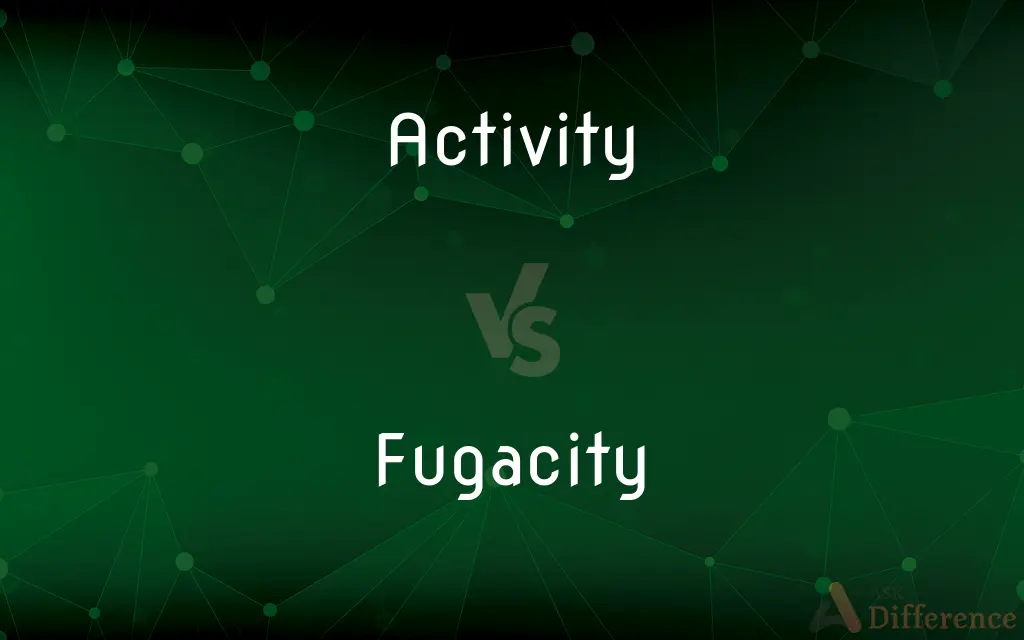Activity vs. Fugacity — What's the Difference?
By Fiza Rafique & Urooj Arif — Updated on April 18, 2024
Activity relates to the effective concentration of a substance in solution, reflecting non-ideal behavior; fugacity is a corrected pressure, used to describe non-ideal gas behavior.

Difference Between Activity and Fugacity
Table of Contents
ADVERTISEMENT
Key Differences
Activity, in chemical thermodynamics, measures the effective concentration of a species in a mixture, accounting for interactions among molecules. Whereas, fugacity is used to quantify how much the behavior of a real gas deviates from that of an ideal gas, effectively a corrected pressure.
Activity coefficients are used to scale concentrations to better represent real solution behavior, especially useful in electrolyte solutions and non-ideal mixtures. On the other hand, fugacity coefficients correct the pressure variable and are crucial for calculations involving real gases under high pressure or temperature conditions.
While activity often applies to solutions, impacting calculations like osmotic pressure and boiling point elevation, fugacity is typically associated with gases, playing a critical role in phase equilibrium calculations and thermodynamic studies.
The concept of activity extends to various fields such as biochemistry, where enzyme activity is a key parameter, highlighting the functionality of enzymes in non-ideal conditions. In contrast, fugacity finds its relevance mainly in chemical engineering and environmental science, where it helps in understanding pollutant behavior and separation processes.
Activity can also be considered in terms of solid and liquid phases, affecting solubility products and precipitation reactions. On the contrary, fugacity is useful in the context of supercritical fluids where it helps describe fluid properties beyond the critical point.
ADVERTISEMENT
Comparison Chart
Definition
Effective concentration in non-ideal solution
Corrected pressure for non-ideal gas behavior
Main Application
Solutions
Gases
Coefficient Type
Activity coefficient
Fugacity coefficient
Typical Measurements
Osmotic pressure, boiling point
Phase equilibria, chemical equilibrium
Field Relevance
Chemistry, biochemistry
Chemical engineering, environmental science
Compare with Definitions
Activity
Often compared to ideality as a reference state.
As activity approaches 1, the solution behavior approaches ideality.
Fugacity
Used in environmental science to study pollutant dispersal.
Fugacity models help predict the environmental impact of industrial emissions.
Activity
Measure of a species' "effective" concentration.
In high salt concentrations, the activity of water decreases significantly.
Fugacity
Measure of a gas's tendency to escape or expand.
Fugacity increases with temperature, reflecting increased molecular motion.
Activity
Influences chemical equilibrium in solutions.
The equilibrium constant is calculated using the activities of the reactants and products.
Fugacity
Essential for thermodynamic calculations in engineering.
Engineers use fugacity to design distillation and extraction processes.
Activity
Used to predict how solutes in non-ideal solutions will behave.
Activity coefficients are necessary for accurate colligative property calculations.
Fugacity
Reflects deviations from the ideal gas law.
At high pressures, the discrepancy between actual and ideal gas behavior necessitates the use of fugacity.
Activity
Adjusted interaction scale for components in a mixture.
The activity of ions in a solution affects the electrical conductivity.
Fugacity
Corrective factor for real gas pressure.
Fugacity coefficients must be used when calculating gas phase equilibria under non-ideal conditions.
Activity
The state of being active.
Fugacity
In chemical thermodynamics, the fugacity of a real gas is an effective partial pressure which replaces the mechanical partial pressure in an accurate computation of the chemical equilibrium constant. It is equal to the pressure of an ideal gas which has the same temperature and molar Gibbs free energy as the real gas.Fugacities are determined experimentally or estimated from various models such as a Van der Waals gas that are closer to reality than an ideal gas.
Activity
Energetic action or movement; liveliness.
Fugacity
Passing away quickly; evanescent.
Activity
A specified pursuit in which a person partakes.
Fugacity
(Botany) Withering or dropping off early.
Activity
An educational process or procedure intended to stimulate learning through actual experience.
Fugacity
A measure of the tendency of a fluid to expand or escape.
Activity
The intensity of a radioactive source.
Fugacity
(physics) A measure of the relative stability of different phases of a substance under the same conditions.
Activity
The ability to take part in a chemical reaction.
Fugacity
Transience.
Activity
A physiological process
Respiratory activity.
Fugacity
The quality of being fugacious; fugaclousness; volatility; as, fugacity of spirits.
Activity
(uncountable) The state or quality of being active; activeness.
Pit row was abuzz with activity.
Fugacity
Uncertainty; instability.
Activity
(countable) Something done as an action or a movement.
The activity for the morning was a walk to the store.
Fugacity
The tendency of a gas to expand or escape
Activity
(countable) Something done for pleasure or entertainment, especially one involving movement or an excursion.
An increasing number of sports activities are on offer at the university.
Quilting can be an enjoyable activity.
Fugacity
The lack of enduring qualities (used chiefly of plant parts)
Activity
The lexical aspect (aktionsart) of verbs or predicates that change over time and have no natural end point.
Activity
(physics) The number of radioactive decays per unit time. Unit for it: becquerel or curie Category:en:Radioactivity
Activity
The propery of substances to react with other substances
Activity
The state or quality of being active; nimbleness; agility; vigorous action or operation; energy; active force; as, an increasing variety of human activities.
Activity
Any specific activity;
They avoided all recreational activity
Activity
The state of being active;
His sphere of activity
He is out of action
Activity
An organic process that takes place in the body;
Respiratory activity
Activity
(chemistry) the capacity of a substance to take part in a chemical reaction;
Catalytic activity
Activity
A process existing in or produced by nature (rather than by the intent of human beings);
The action of natural forces
Volcanic activity
Activity
The trait of being active; moving or acting rapidly and energetically;
The level of activity declines with age
Common Curiosities
What is the primary use of activity in chemistry?
Activity is primarily used to describe the effective concentration of species in non-ideal solutions.
Why is fugacity important in chemical engineering?
Fugacity is crucial for designing processes involving gases at non-ideal conditions, such as in distillation.
In which scenarios is fugacity used over pressure?
Fugacity is used over pressure in scenarios where gas behavior significantly deviates from ideal conditions.
How does fugacity differ from pressure?
Fugacity corrects the pressure of a real gas to reflect deviations from ideal gas behavior.
Can activity be applied to gases?
While typically used for solutions, activity concepts can also apply to gases, particularly in high-pressure conditions.
Where is activity commonly applied?
Activity is commonly applied in calculations involving solutions, such as determining osmotic pressure and solubility.
What role does the activity coefficient play in chemistry?
The activity coefficient adjusts the concentration of solutes to account for non-ideal interactions in a solution.
How does pressure influence fugacity?
Higher pressures typically increase fugacity, indicating greater deviation from ideal gas behavior.
Can activity coefficients be greater than one?
Yes, activity coefficients can be greater than one, indicating stronger than ideal interactions.
How does fugacity relate to environmental science?
Fugacity is used to predict how pollutants behave and disperse in the environment.
How does temperature affect activity?
Temperature can alter activity by changing the interactions between molecules in a solution.
How is fugacity measured?
Fugacity is calculated using fugacity coefficients derived from experimental data or theoretical models.
What factors affect fugacity coefficients?
Factors such as temperature, pressure, and gas composition affect fugacity coefficients.
Why is understanding activity important in biochemistry?
Understanding activity is crucial in biochemistry for accurately predicting enzyme reactions and interactions in non-ideal conditions.
What is the relationship between activity and chemical equilibrium?
Activity directly influences chemical equilibrium by determining the effective concentrations of reactants and products.
Share Your Discovery

Previous Comparison
Chair vs. Stool
Next Comparison
Witchcraft vs. WizardcraftAuthor Spotlight
Written by
Fiza RafiqueFiza Rafique is a skilled content writer at AskDifference.com, where she meticulously refines and enhances written pieces. Drawing from her vast editorial expertise, Fiza ensures clarity, accuracy, and precision in every article. Passionate about language, she continually seeks to elevate the quality of content for readers worldwide.
Co-written by
Urooj ArifUrooj is a skilled content writer at Ask Difference, known for her exceptional ability to simplify complex topics into engaging and informative content. With a passion for research and a flair for clear, concise writing, she consistently delivers articles that resonate with our diverse audience.














































